अरंड के प्रमुख कीट एवं उनका प्रबंधन
Castor is an important oil seed crop the plant has a substantial tap root with many lateral branches which can reach a great depth. Annual cultivated varieties reach a height of 0.9 - 1.5m whilst natural perennial varieties can grow as tall as 6m. As a species, the plants are very variable. Leaves are large, glossy and green with pointed lobes and prominent veins, each develops on a long stalk. The inflorescence consists of an erect panicle with female flowers at the top and male flowers at the bottom. The female flowers open before the male flowers and hence there is a large degree of cross-pollination. The flowering period may be long. The fruits are spherical capsules which become hard and brittle. The seed capsule has thick walls, is spiny and contains 3 coci. Each cocus contains one seed. The castor bean contains 50-55% oil. The oil itself contains a number of fatty acids similar to those in cooking oils, such as oleic acid, linoleic acid, stearic acid and palmitic acid. However, among vegetable oils, castor oil is distinguished by its high content (over 85%) of ricinoleic acid. No other vegetable oil contains so high a proportion of fatty hydroxyacids. Castor oils unsaturated bond, high molecular weight (298), low melting point (5ºC) and very low solidification point (-12ºC to -18ºC) make it industrially useful, most of all for the highest and most stable viscosity of any vegetable oil
Pests of Castor
1. Castor Semi looper Achaea janata Linn.
Nature and symptoms of damage:
The smooth greyish-brown caterpillars feed on the leaves and cause sometimes wholesale devastation of the crop. Damage to defoliation. Older larvae are voracious feeders and leave bare stems veins.
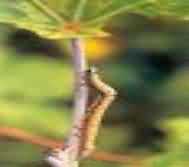
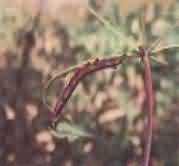
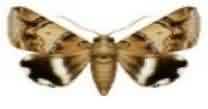
Cultural control
Hand picking of older larvae during early stages. Manipulate parasitic activity by avoiding chemical spray, when 1-2 larval parasites are observed on castor plant.
Biological control
- A number of hymenopterous parasites attack the pest during the various stages of its life-cycle.
- The eggs are parasitised by releasing Trichogramma evanescens minutum @ 50000/acre.
- The larvae are heavily parasitised by a braconid parasite, Microplitis maculipennis.
- Two larval parasites, one a chalcid, Euplectrus sp. and another a braconid,Rhogas sp. have also bee
Chemical control
- Spray Quinalphos 2ml or Chloropyriphos 2ml or carbaryl (50%) 3gm or monocrotophos 1.5ml endosulphan 2ml/lit of water, Carbaryl 0.2 % Quinalphos 0.05 % if 4-5 semi-looper/plant are observed on 30 & 40 days old seedlings.
- Spray neem seed kernal extract (NSKE) 4% synchronising with egg early larval stage.
- Providing bird perches (10/acr) helps in reducing the incidence Castor capsule borer
2. Castor Shoot Borer Dichocrosis punctiferalis Guene.
Nature of damage
The caterpillars bore into shoot and seed capsules and cause extensive damage to the crop and characteristic webbing of capsules along with excreta is seen.
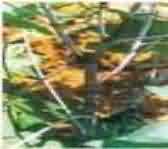
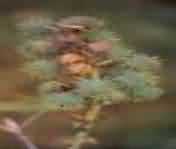

Cultural control
The infested shoots and seed capsules may be collected and destroyed.
Chemical control
- Spray monocrotophos 1.6ml or Dimethiate 0.03% or Quinolphos 0.05 % or Endosulphan 0.07 % or dust the spike with quinalphos (1.5%) or methylparathion (2%), Carbaryl 0.2 %
- Spraying can be done at flowering and 15-20 days later.
3. Jassid Empoasca flavescens Fab
Nature of damage
Curling of leaves due to jassid attack Nymphs and adults suck sap usually from the under surface of the leaves and inject toxin causing curling of leaf edges and leaves turn red or brown. The leaves dry up and shed. Economic threshold level 2-3 adults/leaf.
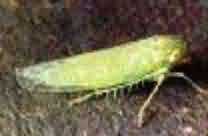
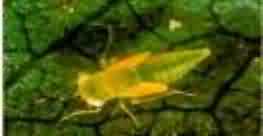
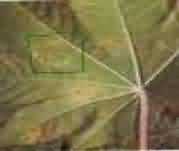
4. White fly Trialeurodes ricini Mishra
Nature of damage
Both nymphs and adults suck sap from leaves.This makes the leaves appear sickly and sooty mould is developed a white fly infestation is severe.High bloom & tripple bloom cultivars are more susceptible.
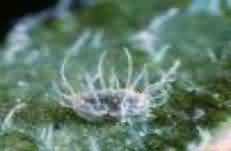
Biological control
- Predaceous spiders, coccinellid larvae and adults feed on the pest and a chalcid parasite parasitises the puparia.
- These should be conserved to keep the incidence of the pest in check.
Chemical control
- The damage of white flies may be kept down by spraying the infested plants with 0.05% malathion or monocrotophos (0.05%) chloropyrifos (0.05%). Early stages neem oil 5ml/lit can be spray on the under surface of the leaf. Stem applications with monocrotophos and seed treatment with Imidacloprid 5gm/kg seed may be done for control. Economic threshold level 8-10 adults/leaf or 20 nymphs/leaf.
5.Thrips Retithrips syriacus
Nature of damage
Very tiny pinkish nymphs and black adults with fringed wings feed both on the upper and lower surfaces of the leaves.The terminal leaves crinkle and appear silvery. If infestation is severe, stunted growth results.
Control: Same as whitefly
6. Serpentine leaf miner Liriomyza trifolii
Symptoms
Leaf miners form tunnels by burrowing in the leaf between the epidermal layers consuming the green tissue as they go. Irregular grayish-green tracks remain in the leaves. In severe cases, the leaves may cease to function and abscise. The adult insect is a small, yellow-bodied fly about 1/8 inch in length. The larvae are small (about 1/8 inch long) white maggots.
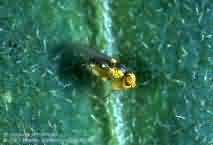
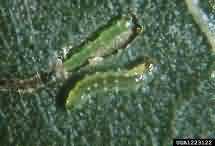
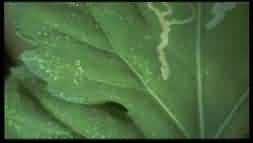
Damage
Punctures caused by females during the feeding and oviposition processes can result in a stippled appearance on foliage, especially at the leaf tip and along the leaf margins However, the major form of damage is the mining of leaves by larvae, which results in destruction of leaf mesophyll. The mine becomes noticeable about three to four days after oviposition and becomes larger in size as the larva matures. The pattern of mining is irregular. Both leaf mining and stippling can greatly depress the level of photosynthesis in the plant. Extensive mining also causes premature leaf drop, which can result in lack of shading and sun scalding of fruit. Wounding of the foliage also allows entry of bacterial and fungal diseases. The minute orange yellowish, apodous larva tunnels the epidermis of leaves making serpentine mines. It is an introduced polyphagous pest occurring on castor, gourds, melons, tomato and leafy vegetables. On castor the incidence is seen from August to October.
Drying and dropping of leaves under severe conditions can be seen.
Chemical Control:
- Spray neem seed kernal extract (NSKE) 4% or triazophos @ 2.5ml/litre of water.
7. Tobacco Caterpillar Spodoptera litura
Nature of damage
Skeletonised leaves. The early instar larvae feed gregariously on the under surface of the leaf leading to skeletonization of the leaves. Later they disperse, become solitary and nocturnal. They also feed on the flower buds, flowers.
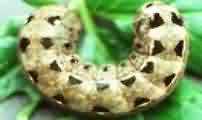
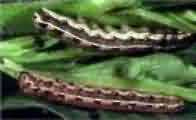

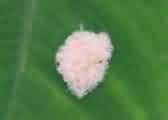
Cultural control
If the area to be treated is small, collect and destroy the egg masses and caterpillars in the early stages of infestation.
Plough up the soil so as to expose the pupae to predators and parasites.
Monitoring the pest with pheromone traps (4-5/acr) helps in timing of treatment.
Biological control
- A large number of parasites have been recorded.
- One ichneumonid larval parasite, Angitia argenteopilosa has been recorded.
- The braconid parasites, one larval and another egg-larval, Apanteles prodeniae and Chelonus sp. have also been recorded.
- The pupae have been found to be parasitised by an eulophid, Trichospilus pupivora.
Chemical control
- To control early stage larvae, spray neem seed kernel extract (NSKE) 4% or Spray Chloropyrifos 2.5ml or monocrotophos 2ml or Quinolphos 2ml or neem oil 5ml in one lit of water.
- As the grownup larvae move down to soil to hide during day time, poison bait (1litre of monocrotophos or 1kg Carbaryl in 10kg of bran, 1kg jaggery, little water to make the bait in to pellets for one hectare) placement at base of the plant helps in killing the larvae.
- Economic threshold level 5-10% infected plants.
Authors:
MANOJ KUMAR JAT, DR. I.S.PATEL* AND DR. K. ROLANYA
Department of Entomology, College of Agriculture
CCS, Haryana Agricultural University, Hisar (Haryana)
Email: nitharwal84@gmail.com
*Scientist, Main pulses research station SDAU- S.K. Nagar (Gujarat)
